Full breast digital mammography with an amorphous silicon-based flat panel detector: physical characteristics of a clinical prototype
- PMID: 10757607
- PMCID: PMC4280189
- DOI: 10.1118/1.598895
Full breast digital mammography with an amorphous silicon-based flat panel detector: physical characteristics of a clinical prototype
Abstract
The physical characteristics of a clinical prototype amorphous silicon-based flat panel imager for full-breast digital mammography have been investigated. The imager employs a thin thallium doped CsI scintillator on an amorphous silicon matrix of detector elements with a pixel pitch of 100 microm. Objective criteria such as modulation transfer function (MTF), noise power spectrum, detective quantum efficiency (DQE), and noise equivalent quanta were employed for this evaluation. The presampling MTF was found to be 0.73, 0.42, and 0.28 at 2, 4, and 5 cycles/mm, respectively. The measured DQE of the current prototype utilizing a 28 kVp, Mo-Mo spectrum beam hardened with 4.5 cm Lucite is approximately 55% at close to zero spatial frequency at an exposure of 32.8 mR, and decreases to approximately 40% at a low exposure of 1.3 mR. Detector element nonuniformity and electronic gain variations were not significant after appropriate calibration and software corrections. The response of the imager was linear and did not exhibit signal saturation under tested exposure conditions.
Figures






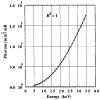
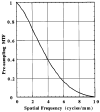



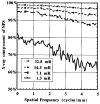
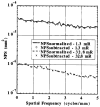
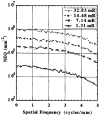
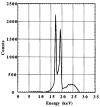

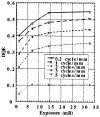
References
-
- Jing Z, Huda W, Walker JK. Scattered radiation in scanning slot mammography. Med Phys. 1998;25:1111–1117. - PubMed
-
- Persliden J, Carlsson GA. Scatter rejection by air gaps in diagnostic radiology. Calculations using a Monte Carlo collision density method and consideration of molecular interference in coherent scattering. Phys Med Biol. 1997;42:155–175. - PubMed
-
- Fahrig R, Mainprize JG, Robert N, Rogers A, Yaffe MJ. Performance of glass fiber antiscatter devices at mammographic energies. Med Phys. 1994;21:1277–1282. - PubMed
-
- Roehrig H, Yu T, Krupinski E. Image quality control for digital mammographic systems: initial experience and outlook. J Digit Imaging. 1995;8:52–66. - PubMed
Publication types
MeSH terms
Substances
Grants and funding
LinkOut - more resources
Full Text Sources
Other Literature Sources
Medical
Miscellaneous

